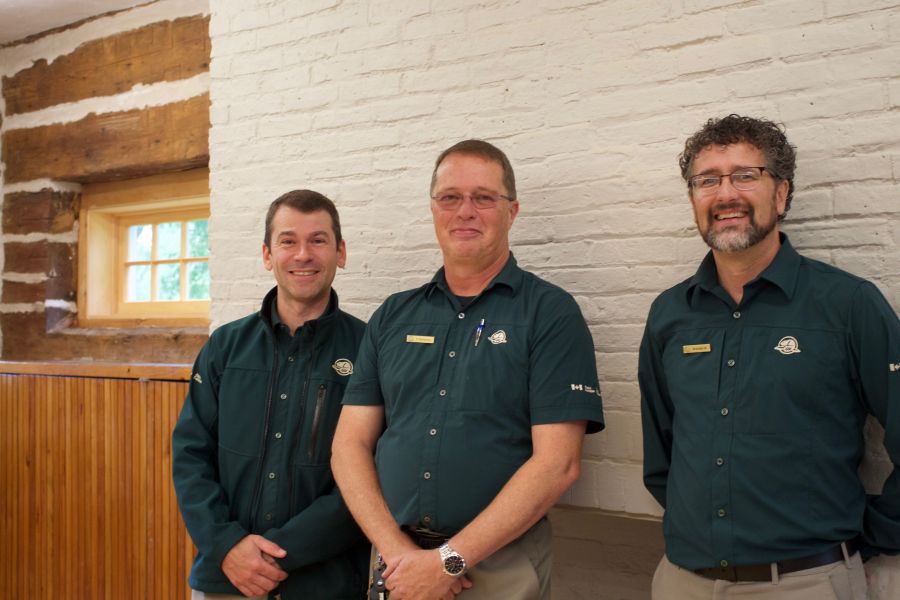Butler’s Barracks grew a few inches recently due to a $13.5 million federal infrastructure investment in Niagara’s National Historic Sites.
The money will go towards the restoration of several historic structures, improving visitor accessibility, and shoreline protection measures. The work is being done specifically at Fort George, Fort Mississauga, Butler’s Barracks and Navy Hall.
Butler’s Barracks received new insulation on the outside of its historic walls to better protect the members of the southwestern Ontario field unit of Parks Canada, who now use the building as their main office.
The mandate of Parks Canada is to protect and present history and national historic sites.
“We connect people with nature and history,” says Louis Lavoie, field unit superintendent.
One currently popular way to achieve these goals is adaptive reuse of the building. Compared to the barracks — built in 1854 — the building has seen many iterations and is now re-purposed as offices to be seen and visited by the public as they interact with Parks employees.
The work that is being done restoring historical buildings as part of the federal infrastructure refurbishment is care-filled and respectful.
A good example of the layers of time in these buildings is an I-beam nestled into an original wooden beam during a renovation in the 1970s.
“In this kind of work, sometimes things go your way, sometimes not,” says Brendan Buggeln, asset manager. “This was a fortunate example of the former.”
The ceilings in the old barracks were originally made of expanded lath — one piece of wood sliced and stretched into narrow strips. A corner of the lath has been left exposed in the showcase of a boardroom on the first floor of the two-storey structure on the Commons.
The buildings that share the Commons with the barracks will also be stabilized and tidied up. Chris Zoetewey, technical services officer and a local, remembers (perhaps unauthorized) parties in the Junior Officers Commissary building, and looks forward to seeing what the next use for the structure might be.
“Our first priority is to make sure the structures are sound, and not compromised by weather. Then we look for opportunities to use the buildings in innovative ways. A building with people using it is always in better shape than one left empty,” says Lavoie.
Fort Mississauga is a fine example of the partnerships Parks Canada seeks and celebrates in the community. The Niagara-on-the-Lake Golf Club is the only golf course on a historical site in Canada. “They are outstanding partners,” Lavoie says.
Recent work at the Fort has been diverse. Erosion on the water’s edge was mitigated with boulders in the first phase, and the next phase will take the barrier up the river another 500 metres.
“Mother Nature has been taking bites out of the shoreline,” says Lavoie.
Extensive work has been done to extend the shoreline, and the land has been landscaped and revegetated. The next phase will begin shortly, he said.
On the fort itself, Buggeln is excited to point out the repair in the brick entrance walls. He jumps enthusiastically into one of the powder magazines to show off the buttressing that his been done inside to stabilize the structure. As asset manager and an engineer, Buggeln is passionate about moisture management.
“This is a double arch,” he says, pointing to the ceiling. “There is a foot of air between the bricks to improve ventilation.” Later, putting his hand on the wall that leads up to the sally-port he says, “200-year-old bricks don’t like moisture.” A wicking system has been created to draw water away from the vulnerable materials.
The fort’s tower is in the process of being stabilized. Stacks of bricks salvaged from the floor of the structure will go toward repairs. Yoetewey, ever the historian, says the bricks originally came from the chimneys of the houses that were burned in the War of 1812. “The fort was originally built in a hurry in 1814. The walls are 10 feet thick at the bottom, tapering to eight-and-a-half feet the top. The rounded corners were designed for glancing the blows of cannon balls and bullets. This structure is rated bomb-proof.”
The first phase of the work on Fort Mississauga will also involve replacing the roof. And then? “The Shaw Festival did pop-up theatre here this summer,” says Lavoie. “We have a partnership with e-Skoot Niagara for tours of all the sites. We’re always looking for more of these relationships with the community. There are never too many good ideas.”
Fort George is also a beneficiary of the infrastructure investment, boasting smooth, broad accessible paths, bright lighting to guide you along them, and a new flagpole. “The old flagpole base was 80 per cent moisture,” says Zoetewey. The blockhouses will all be re-sided and given new windows. With his keen focus on adaptive reuse, Lavoie says, “Many people don’t know we have a commercial kitchen and do corporate programs here at Fort George.”
Navy Hall, another significant national historic site, is also getting some love from the program. The ramp to the dock has been rebuilt with a solid surface, the retaining walls have been repaired, and the dock has been rebuilt. Work is currently being done on stairs and access to the basement.
“The beauty of this job is there is always something more you can do,” says Lavoie. “There are so many different ways to expose history. We’re definitely open to conversations. We want the community to use these properties creatively,”
Over to you, NOTL — how would you like to see these properties used?










